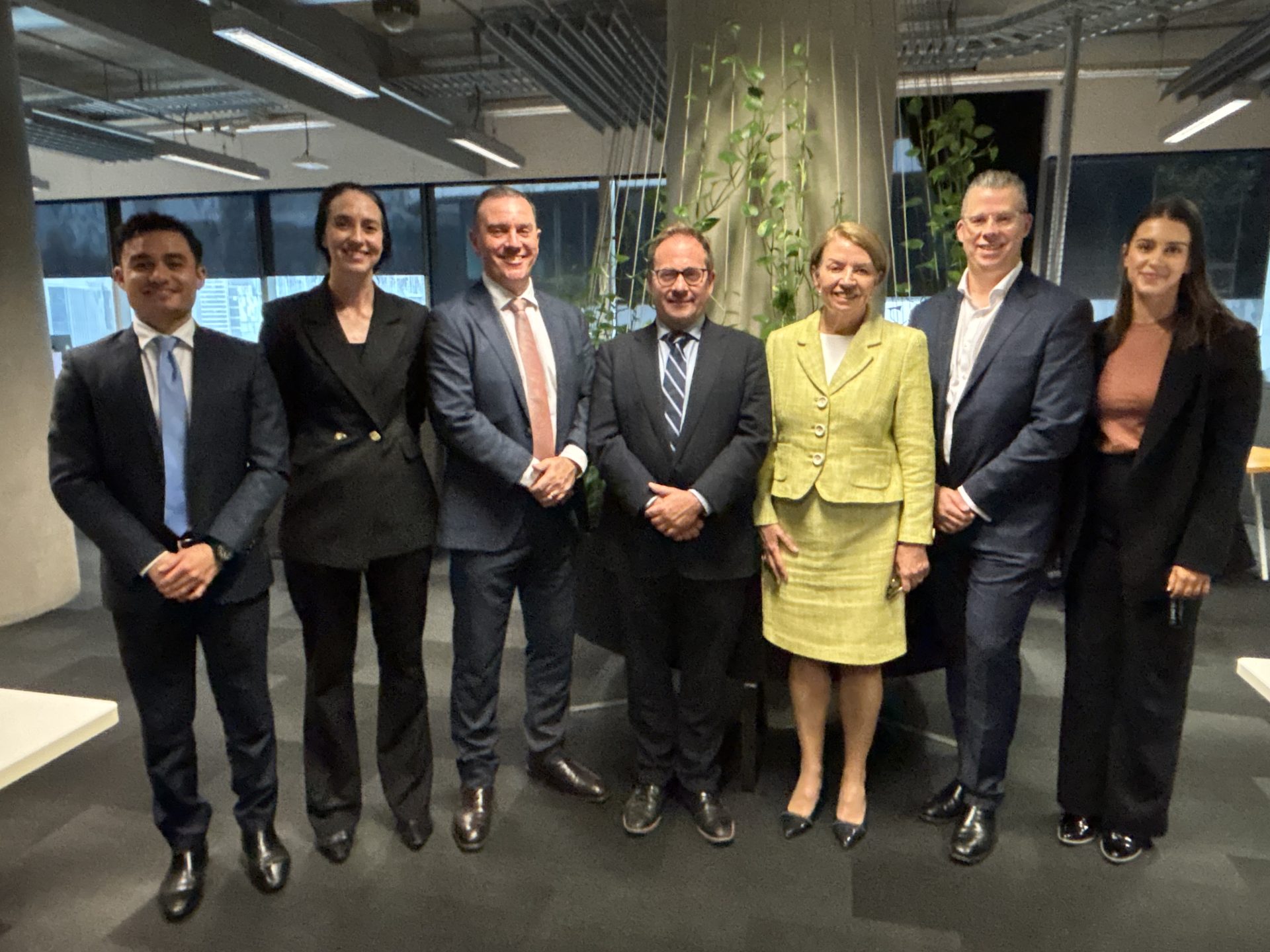This speech was delivered by NAB Chief Digital, Data and Analytics Officer, Angela Mentis, at the Australian British Chamber of Commerce on 16 November 2022.
Introduction
Good afternoon and thank you for the warm introduction. It is a pleasure to be here, and I thank the Australian British Chamber of Commerce and David McCreadie for inviting me today. I am honoured to speak to you all, as the Chief Digital, Data and Analytics Officer at NAB.
I have been in this role now just over one year, and to be honest, that title can still sometimes sit uncomfortably with me. I am a 30-plus year career banker and since 2014 I have had the privilege of sitting on the Executive Leadership Team at NAB.
My banking career is deeply grounded in the fundamentals of running a bank and serving our customers well. Until now, nowhere on my CV had been leadership roles which centred on the technical expertise behind digital, data and design. But this is the world we live in now.
When I started in banking, it was, as it is now, all about the customer, but everything was very human, and very centred on your relationship with the branch or your banker. What’s different today, is that everything is digital.
Over 70 per cent of our personal customers engage with us only digitally. Our mobile and internet banking platforms see over a billion logins a year – that’s about 17 times the traffic we see through our entire retail branch network.
Digital, data and design are the domains that now form the primary connection to our customer, they are our levers for delivering exceptional customer experiences. My role, is to bring this customer mindset to the technology, to create digital which is human.
And I think about that in four ways:
– It has to be simple and easy to use
– It has to be personal
– It has to be inclusive
– And it has to be trusted
And as we do this, we must equally consider, not just the humans who consume our experiences, but the humans who design and build them.
Simple and easy to use
But firstly – simple and easy.
Twenty-odd years ago when we first saw the emergence of internet banking, it was all about convenience – the ability to do the basics of banking anytime, anywhere.
Then over the last decade we have seen banks focus investment on seamless, simple, end-to-end digital experiences that have vastly removed the need for human interaction. This includes verifying identity, applying for products, having your home loan decisioned and settled.
There are three areas in particular we see opportunity for far more simplification for our customers. Where a well-designed digital experience can deliver easier, more consistent outcomes for our customers than the best-intentioned human. They are verifying a customer identity; supporting a small business with administration overheads; and receiving a customer’s data to support delivery of a banking service.
The process of digitally verifying identity is one of the first points where humans and technology collide – where the human needs to convince the technology they are who they say they are, to a robust level of assurance, using the 100 points of ID checklist. This is a process prescribed in 1988, before there was any imagining of the digital era we would find ourselves in today.
Recent events have brought this topic into focus. We believe there are more secure ways for customers to meet identification requirements without the repeated passing and storing of personally identifiable information across multiple organisations. We have partnered with Australian Payments Plus to bring the Connect Id industry initiative to life next year. This is an initiative which is focused on delivering a safer, more secure, more convenient way for our customers to prove that they are who they say they are based on a verified digital identification.
We are also focused on making it simpler for our small business customers to manage cashflow and run and grow the business, through digitally delivered experiences giving the support of a trusted relationship.
· Our recently launched NAB tap & pay which helps our small business customers to take card payments anywhere – just by using their mobile phone.
· Our investment in and partnership with Thriday is designed to seamlessly automate the banking, accounting and tax processes, some of the most administratively burdensome processes small businesses face.
We are also looking to utilise open banking infrastructure, as an active data recipient, to help us enable instant credit decisions. This will allow a customer to digitally collate and submit their banking data to provide a complete financial understanding of that customer and their transactional behaviours. It will have a transformative effect on the ease, speed and personalisation with which we will be able to decision a new application and provide support to that customer’s financial wellbeing.
But while digital helps simplify life for our customers, it is not usually enough to bind them to a brand – and that’s where relationships come in.
It needs to be personal
NAB prides itself as the relationship-led bank, and relationships are human and they are personal. They are the reason NAB is Australia’s leading business bank. So, whilst more of our experiences have gone online, and delivered ease and convenience for our customers, it has created a challenging trade-off, for they have lacked the personalisation and human connection that’s critical to maintain.
But we are now seeing that shift. A shift towards more proactive and personal digital engagement, fuelled by customers’ data,
And we know that our customers want and expect this. The latest Deloitte Australian Privacy Index reported that 80 per cent of consumers see value in personalisation, however only 30 per cent are happy with their current experiences. We need to address this expectation and experience gap, by being smarter with our use of data to power personal experiences, tailored to the needs and preferences of our customers, delivered in a trusted and transparent manner, with human support if needed.
In 2023, we are delivering what we call a “customer brain” that accelerates our ability to take all that we know about our customers and use that to deliver human like, personal experiences, that are relevant for the moment, in any channel – digital or human, inbound or outbound. We can anticipate a customers’ needs and put meaningful value in their hands and we can do this digitally and at scale, through data and analytics.
We can see when customers are struggling financially, we know when they’re not using all of the features of their accounts and we understand that they want to know how their loan application is progressing. Imagine if rather than having to come to us, we are reaching out to them and we’re doing it consistently across any channel that they’re in.
We’ve already started on this and just by adding some insight about a customer, we’ve seen a 43% increase in customers clicking on a banner because it’s just more relevant to the customers who are seeing that banner.
It also means enabling our relationship bankers to be exceptional and valued. To equip them with the insights for our business customers to help them run and grow their businesses. We can take what the very best bankers do every day and systematically put that in the hands of all of our bankers.
It has to be inclusive
And thirdly, to be a good human means we don’t leave anyone behind. That is seen by being digitally inclusive, where “everyone has equitable opportunities to participate in society using digital technologies”.
To enable digital inclusion, people need access to digital technologies, the motivation to use them, trust that they are safe, and the digital skills to get the most out of them.
At NAB, about 7 per cent of our customers still rely entirely on our branches and contact centres, and through the pandemic we saw their vulnerability.
I was CEO at BNZ at the time, and we had set up a dedicated phone line for our over 70 customers who needed extra support. I would listen in on those calls, and I recall one with a customer who was 103 years old. In that call, we were able to coach her how to use digital banking, we watched to ensure she could do it herself – pay her bills, and transfer money – when she hung up, she was so happy and confident that she had that independence back again.
The digital skills and literacy gap is one of the biggest barriers to adoption across our economy.
According to Deloitte: one out of three Australian organisations expanded their online presence in the first three weeks of the pandemic, while 90 per cent adopted new tech to support continuity of the organization. And we learnt that those businesses who pivoted early and leveraged digital tools are the ones who survived and even thrived.
A 2021 behavioural study by Xero found that small businesses which readily adopt new technology enjoy an average 120 per cent higher revenue. Yet, only 1 in 5 considered themselves digital adopters.
If left unaddressed, this digital skills gap risks compounding existing inequalities as the digital transformation rolls on. To take full advantage of the promise of digital technologies and to ensure no one gets left behind, we need to act quickly and collectively to ensure inclusive access to digital training for all who want it.
This is a job for both government and business, and one I am focused on seeing us collaborate.
It has to be trusted
The last aspect of making digital human; is it has to be trusted. Fortunately, research shows that consumers continue to show a high level of trust in incumbent banks, not just with their money, but with their personal information. As I mentioned earlier, they now also have an expectation that their information is used to provide personal propositions and experiences.
EY’s 2021 NextWave Global Consumer Banking Survey proposed that the strength of trust is most motivated by human like traits, such as trustworthiness and personal relationships.
However, banks can’t be complacent, for the data also shows that in Generation Z, our longest tail of future customers, trust looks something quite different. For them it is convenience, transparency and control, things more associated with digital and tech.
So, the question is, not what trust do we hold now, but what will trust look like in the future, as these human and digital like traits converge?
Certainly, it is also clear that cybercrime is rapidly changing the landscape of trust, it is one of the greatest threats of our time. It is impacting how customers look at organisations to not just use their data for the right purpose, but also to secure and protect it from harm.
Every month, NAB has more than 50 million attacks on our digital channels. These are blocked by controls we have in place, but you can see that when you extrapolate that level of attack across the economy, it is a big and serious problem.
At NAB, we use technologies such as biometrics and data science to monitor accounts and detect unusual activity. We partner with government and industry on a range of key initiatives, but it’s certainly a challenge that keeps executives up at night. In 2021 in Australia, it was reported almost $1.8 billion was lost to scams and fraud – a figure more likely to be north of $2 billion when we consider the amount that goes unreported, and sadly, it is growing every year.
Education is also a key line of defence. We need to help the community be more aware of what a scam looks like, and how to protect themselves. Over the last year, NAB has run 70 education webinars for our customers; that’s six every month, and our security hub web pages receive over 75,000 visits a month.
After attending one of these webinars, one of our customers was able to avoid falling for an invoice scam. Because they’d attended the session, when they received an invoice asking for payment to be paid to a new account, they knew to confirm it. It turned out to be a scam, saving them $450,000. They were very appreciative.
One of our bankers who attended a session was also able to avert a $6 million invoice scam after noticing some inconsistencies in the payment request, so called the customer to check. It turned out their email account had been compromised and the bank account details altered. Their vigilance saved their client $6 million and a lot of stress and emotional strain.
That is what creating trust and being there for our customers when they need it looks like.
The humans who design and build it
Simple, personal, inclusive and trusted – those are the four areas we are focused on to make digital human. But they don’t just happen by technology alone; we need humans.
So, I am now going to close with some observations on how we bring our people together to build these humanistic experiences.
The first thing is that I want every colleague in our Digital, Data & Analytics division with a mindset that they are in a customer facing role, for they are.
Secondly, is to elevate the role of design. When I was appointed to this role, one of the first things I did was go on a global search for a Chief Design Officer. Technology without design is powerless. It is design that shapes technology into exceptional customer experiences and relationships, that deliver on all of the human qualities I have discussed today.
And thirdly, and not insignificantly, we need to be attracting, retaining and developing the best talent. This is no small challenge.
At NAB, like many organisations, we are faced with critical labour and skills gaps across data, digital, cyber and technology – with some 500 roles vacant across these disciplines. We are not just competing with other banks, we are competing with every business for these same skills, and there are simply not enough people who have them.
According to the Technology Council, Australia needs more than one million people working in tech and digital jobs by 2025. That is about 280,000, or around 40 per cent more people than we have working in these areas today.
We need to train people in the digital and data skills needed today and, in the future, and we need to keep advocating for more modern education curriculums, more skilled immigration, a faster visa process, and more compelling pathways to permanent residency.
That is not a challenge for Government alone. We also need to create opportunities for our current workforce to upskill and re-skill.
Since 2018, we have trained thousands of colleagues in cloud technology which has resulted in more than 4500 industry-recognised cloud certifications. We have developed specialist guilds (or communities of practice) across data science and analytics, as well as human centred design, and our people have access to free, world-class online training offered through platforms such as Udemy and Coursera.
Our Return-to-Work program has also helped those looking to switch or relaunch careers after an extended break. Colleagues such as former events planner, Erinea Gloria, who was placed on a 12-month internship and within that time was offered a permanent role as Head of our Technology Careers team.
In conclusion
In conclusion, I am excited to be leading the Digital Data & Analytics division at NAB, and to hold the privilege of having such influence over the experience so many of our customers will have with NAB through our digital channels. It brings all of my experience leading and building relationship teams and running Customer Divisions, to one where we can bring the best of our human frontline, to our digital frontline.





